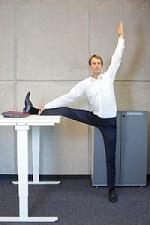Come on - stand up - it’s good for you!
March 07, 2018

Years of research support the idea that sedentary lifestyles lead to negative health effects like weight gain, poor circulation and even increased levels of stress and anxiety. Because we spend a considerable portion of our day at work, standing rather than sitting during that time has the potential to yield significant benefits.
One of the leading trends in office furnishings is the introduction of desks designed for workers to stand rather than sit to do their work. There are also desks that adjust to various heights to allow for alternating between sitting and standing throughout the day. When all factors are considered, the sit/stand option is usually best option.
Many employers are making this investment in their workers’ health and wellbeing. If you are considering it, here are a few points to consider:
The successful switch to standing or sit/stand desks hinges on worker attitudes toward the change. Before making the decision to change from conventional desks or workstations, get input from workers who will be affected. Though there are good reasons to make the change, there will be challenges to be overcome in the beginning. The benefits of making the switch can only be realized if the desks are used as intended.
Remember that changing the desk is only part of the implementation. Other changes in the workspace might be necessary if workers are to gain the full benefits. Chairs might need to be replaced, and anti-fatigue floor mats are recommended to alleviate fatigue than can result from standing for long hours. Other elements on the desktop, like computer monitors, will need to be adjusted and realigned, too.
While the standing or sit/stand desk can be a desirable option in terms of worker health and comfort, be sure to consider the impact of the change. For example, in a shared workspace, standing desks reduce privacy. If standing desks are used, it might be necessary to reconfigure office layouts if privacy issues are a concern.
Though there may be challenges to taking this step to make your work environment more conducive to worker health and wellbeing, there are long term benefits as well. Reducing worker pain and discomfort alone can reduce absenteeism and increase productivity. The other benefits may take longer to accrue but showing your concern for employee health and well being can produce an immediate improvement in all areas of performance.
Have you considered introducing sit-stand desks in your workplace?
Photo credit: copyright: endomedion
< Return to News